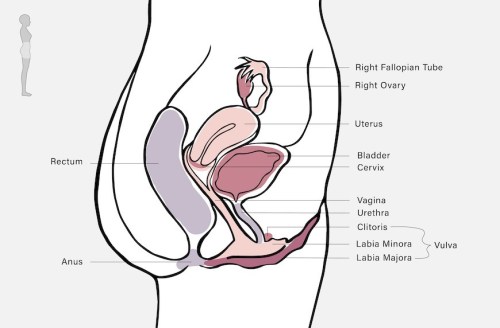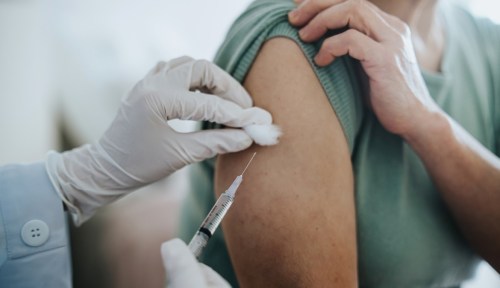Here’s a non sequitur to trot out at your next party: According to dictionary.com, searches for “vulva” are up 817 percent in 2019. Which, what? How do we not know what this is by now?
If you’re a person with a vagina, we think it’s incredibly important that you know your bits like the back of your hand—especially since your reproductive system (of which the vulva is a part!) has huge implications for your overall health and well-being. So with the help of Carolyn DeLucia, MD, FACOG, resident OB/GYN at VSPOT in New York City, we’re here to walk you through the ABCs of your nether regions. So sit back, relax, and remember this female reproductive system anatomy for good.
Check out this diagram of the female reproductive system, and then read on for the full definitions of everything you’ve got going on ~down there~.

Anus
When you call someone a butthole…well, you’re really calling them an anus. It’s the opening to the rectum and large intestine where solid waste comes out, and is separated from the vaginaby a centimeters-long strip of skin called the perineum. (It can also be a place to incorporate into foreplay and beyond.)
Cervix
The cervix is the mouth of the uterus, says Dr. DeLucia, acting as a canal between the vagina and the rest of the uterus. Semen passes through here during unprotected sex in order to potentially fertilize a mature egg in the uterus. If you have an intrauterine device (IUD), your OB/GYN had to push it through your cervix (the painful part) in order to implant it.
Clitoris
Chances are you don’t need a lesson on your clitoris, which sits directly above the opening of your urethra. The small “bud” so to speak on the outside of your body is actually just the tip of the iceberg—two-thirds of the clitoris is inside of the body (and it’s shaped kind of like a tulip). Dr. DeLucia says the clitoris has 8,000 nerve endings, which is double the amount of nerve endings in the penis.
Fallopian tubes
Dr. DeLucia says to think of these as the roadway through which eggs pass from an ovary to the uterus. “There is one ovary and one tube on each side of the uterus,” she explains. “The fallopian tubes actually have fingerlike projections that receive chemical signals to identify the ovary and capture the egg that is released.” The released egg travels through the fallopian tubes to the uterus, where it waits to be fertilized.
Labia majora
These might sound like a big deal given their name, but in reality they’re just the larger outer skin folds of the vulva. Their larger size allows them to fold over the labia minora and the vagina, enclosing everything in a safe little cocoon.
Labia minora
“The labia minora are two small folds of soft tissue on each side of the opening into the vagina,” Dr. DeLucia says. They’re home to a plethora of blood vessels, which become engorged during stimulation.
Ovary
“The ovaries are the two main hormone-producing organs that hang out by the uterus,” Dr. DeLucia says. (According to the Mayo Clinic, they’re about the size and shape of an almond.) You have a pair of them, one on either side of your uterus. “They release estrogen, progesterone, and testosterone,” she says. The ovaries also produce eggs, and each ovary alternates between releasing mature eggs each month during your cycle.
Rectum
The rectum is directly connected to your anus, and is the last section of your large intestine. While the actual purpose of the rectum is to store feces, it also can be a place for a finger, toy, or penis if that’s your thing.
Urethra
“The urethra is the small tube that works as the exit for urine from the bladder,” Dr. DeLucia says. The opening of the urethra sits directly below the clitoris and slightly above the vaginal opening and anus. Because all of these orifices are relatively close together, bacteria can potentially travel from the anus or vagina up the urethra, causing a urinary tract infection (UTI). Hence why we should always be wiping front to back, y’all.
Uterus
The pear-shaped organ is a major player in the female reproductive system. “It has thick muscular walls and is where we house the fetus until it’s ready for birth,” Dr. DeLucia says. Every month, the uterus develops a thick lining in order to house a developing fetus. If an egg isn’t fertilized, that uterine lining sheds from your uterus in the form of your period. For those of us who have an IUD, the uterus is where it lives for three to 10 years, depending on what type you have.
Vagina
Technically speaking, “the vagina is the tunnel that leads to the uterus or womb,” Dr. DeLucia says. It averages at about four inches deep, although that varies from person to person. It’s made up of muscles and tissues that expand (up to eight inches, according to Planned Parenthood) during arousal or childbirth.
Vulva
Last, but certainly not least, we have the vulva. In the wise words of Dr. DeLucia, “It’s all the [external] stuff we see.” Think: clitoris, labia, and vagina. That wasn’t so complicated, now was it?
Since we’re way past TMI at this point…what should you do about a stuck tampon? And here’s how to give your uterus a spiritual spring clean.
Sign Up for Our Daily Newsletter
Get all the latest in wellness, trends, food, fitness, beauty, and more delivered right to your inbox.
Got it, you've been added to our email list.











